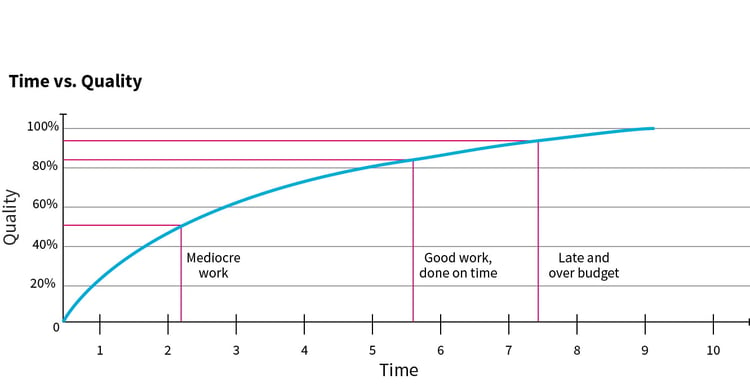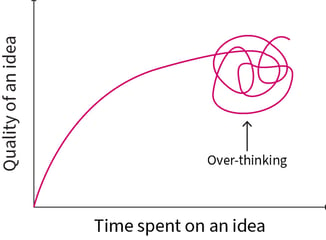A copywriter’s first steps with AI
May 26, 2023

If you are conscious, you spend a lot of time referring to time. You may not realize it because time-based terminology is so weaved into our language and daily schedules.
There’s no escaping time; it’s a currency that you have to spend to do literally anything. And just like other currencies, the general consensus is that “more is better” and “too much is never enough."
When it comes to copywriting or other non-templated creative work, I tend to agree. So how do you balance time and quality when it comes to doing creative work on the clock— and how do you know when your piece is actually finished?
Clearly there is a connection between time and quality. The question is, “Does more time always result in more quality?” I think all creatives would agree that there is definitely a point of diminishing returns where additional time yields little increase in quality and may even do damage. Writers in particular recognize this as the place where they start pulling their own hair out.
In a 2008 article, Ann Forsyth, then a professor of urban planning at the Harvard Graduate School of Design, studied the challenges of doing quality work on time.[1] She portrayed the time vs. quality relationship as being logarithmic, meaning that quality accelerates quickly out of the gate but slows considerably as the work nears completion and becomes more nuanced.

There are a few interesting implications to this graph:
I think writers, in particular, are well aware of this phenomenon. After the research process, the first phase of a writing project is basically a brain-dump of unrefined raw information onto the page, so things generally proceed at a good pace. But progress slows considerably when you start massaging the copy into a solid first draft.
At that point, you feel like you’re 80% there and just need a little more time to polish it up. However, this is also the place where you’re discriminating your work at such a detailed level that trying to attain that extra 10% in quality ends up taking much longer than you allowed for.
Add a looming deadline to the mix, and you have a recipe for stress and anxiety. So, what’s a pseudo-perfectionist to do?

Whenever I write (or do almost anything for that matter), there is rarely an occasion where I don’t think, “I could’ve done a better job if I had more time.” But through experience, I’ve also witnessed the other side, where I’ve invested way too much time (and/or frustration) for little net gain—like spending all day cleaning the house to perfection only to have my two Saint Bernards “restore it” in about 20 minutes.
Writing isn’t like painting a picket fence. First off, you have to be in the right headspace for it, and secondly, there’s no definitive place where you suddenly run out of fence and know you’re done with the job.
As you’re wrapping up a writing project, here are five suggestions to help you cross the finish line:
Any type of thoughtful writing is inherently a personal affair. The words we choose and the order we put them in are like a fingerprint we leave behind. It’s no wonder that, as writers, we get so introspective about the copy we produce. Even when we do client work and have to adapt our craft to the client’s brand and messaging, we still strive for a measure of personal satisfaction.
Too often, we write to our own personal standards, thinking that only then will it be good enough for the client. That’s a lot of extra pressure we don’t need. Writing for someone else is difficult enough without artificially raising their standards to match your own. Remember that your standard of quality is likely going to be higher than those you are writing for.
To be clear, I’m not advocating for doing less than excellent work. But I do want you to have a safe and sane exit strategy the next time you find yourself face down at the keyboard with a deadline looming over you like the sword of Damocles.
With that, I hereby declare this blog “perfect enough.” Until next time, write on!
[1] Ann Forsyth, “Skills in Planning: The Time vs. Quality Opportunity Curve,” Planetizen, November 1, 2008.
We take pride in a team loaded with smarts, wit, and ideas. If you'd like to have a smarter, wittier inbox filled with ideas each month, subscribe here to the MarketReach Blog, and we will let you know when there is something new you might like!

Need us now? Just want to learn more? We’d love to talk.